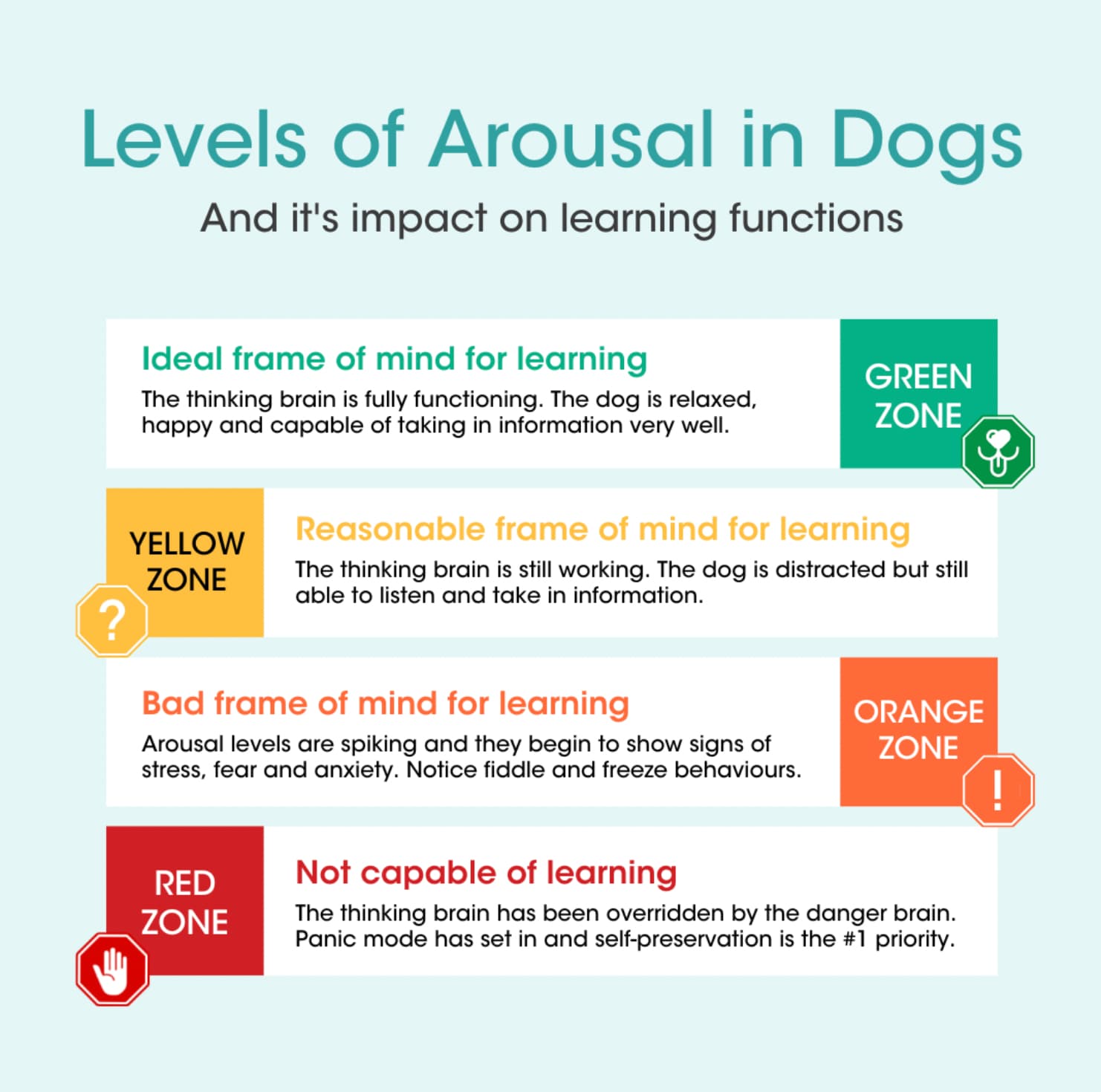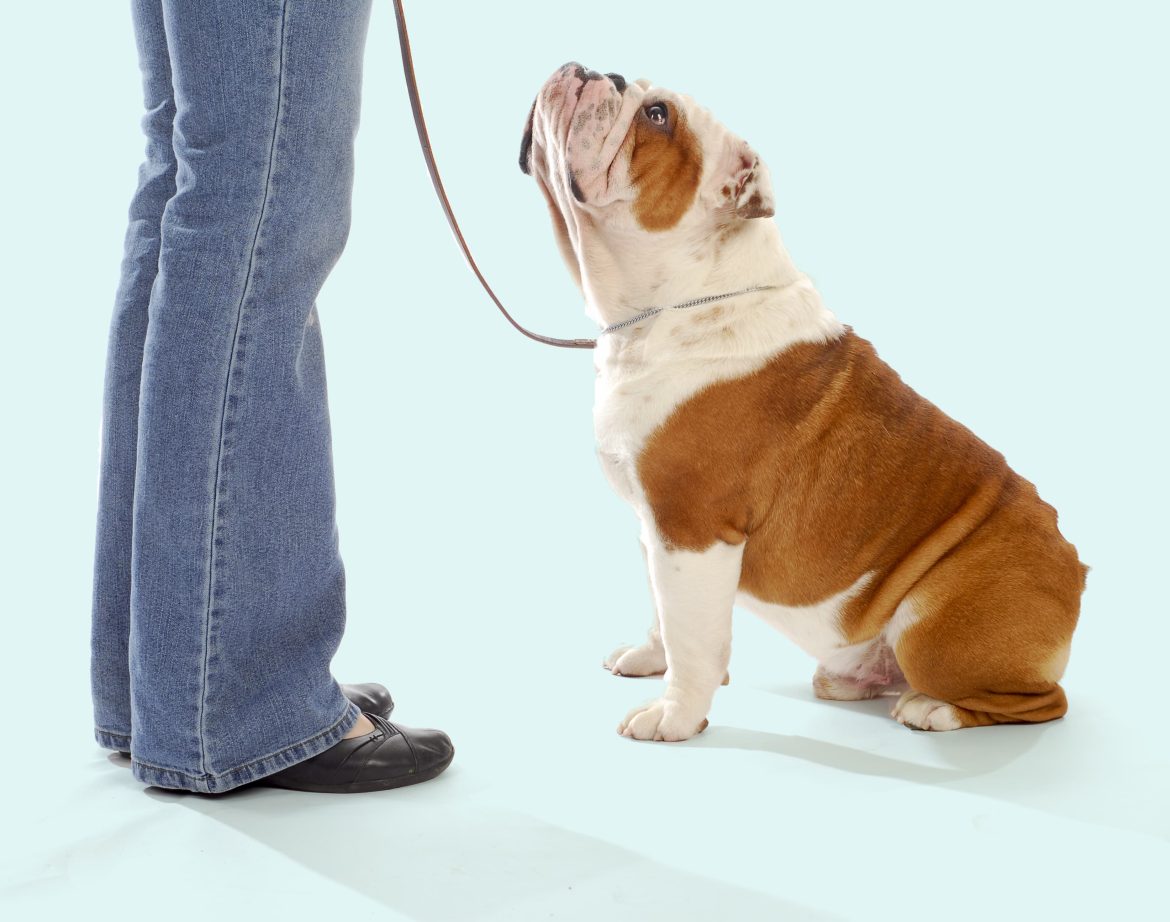Training is something that should be continued throughout a dog’s life, but when is the ‘right time’ to provide training for your dog?
The good news is there are always opportunities for them to learn. Whilst there are optimal times for training and we want to ensure that a dog is in the ideal mindset, it’s important to remember that our dogs are always learning, even when we’re not teaching them so we need to optimise learning opportunities.
Training during the optimum arousal levels
There is no right time of day for every dog, but there is a mindset and time frame that we can optimise and this is what the ‘right time’ means. The most important factor in creating the right time is the dog’s arousal levels; referring to the image below, the green zone is ideal and the yellow is still functional. Environmental factors largely contribute to creating the right time, taking into consideration things that might influence the dog’s mood such as other dogs or loud noises like construction, music or yelling. Environmental factors are primarily influential at the time they’re present, but it’s important to consider the after-effects of them and that a dog will need time to decompress to get back to a stable arousal level. For example, if a dog is afraid of thunderstorms and there is a nasty storm it’s best to wait several hours or a day before focusing on training and instead prioritise a positive environment and comforting them back to an ideal mindset.
External factors influencing training
External factors are easy to spot and often avoid, internal factors that contribute to the dog’s mindset can be more difficult to interpret or understand as they can’t simply tell us how they feel. Sleep, diet, hunger, health, pain, and mood are very impactful on how a dog can respond and learn. It won’t always be easy to tell something isn’t right until you try and the dog shows they’re not able to focus or listen.
When a dog’s internal balance is off if they’re tired, too full or not feeling well it inhibits their ability to focus and therefore their ability to learn. Whilst these factors are not completely controllable, we can make an environment that enables them to make the right decisions and optimise their internal environment. Simple things like putting their bed in low-traffic areas so they can get un-interrupted rest and sticking to a routine for eating, exercise and social interactions.
As a Sitter, it can be increasingly difficult to control this when the dog is moving environments or undergoing change like having the owners away so, it’s important to make an extra effort to nurture factors like this that impact their internal well-being.
 How to determine the ‘right time’ for dog training
How to determine the ‘right time’ for dog training
The real question is, how do we know it’s the right time? There are a few ways to help determine if the ideal training window is open but the easiest way to tell is by knowing a dog and understanding their body language. Dogs thrive off of routine, as carers, a routine helps us gauge their mood throughout the day and other important factors like when they’re hungry, normally rest or toilet.
Putting these two components together, you can gauge a good prediction of a dog’s headspace. Body language is such a powerful tool because it’s how dogs communicate with us, for example, if a dog was yawning lots, itching and hyper-aware of their surroundings they’re most likely stressed and it would be an awful time to do some training. A great example of a ‘right time’ to train would be after a dog has had their morning nap post brekkie and it’s not too hot. They’ll be well-fed and rested and looking for something to do until their next nap.
It’s all about context, if a dog is super food motivated it’s okay to use their meal to train so starting a session hungry is a positive. It’s useful to do some decompression before a training session to help bring the dog to a stable arousal level, for example letting them sniff around the park for a while before starting a training session.
This time can be tricky to catch when you’re not with the dog 24/7, as a dog walker or trainer schedules a time to see the dog they can’t just wait until the dog is ready. This is where it’s important to be proactive and communicate with the Owner to create an ideal environment and time. You can run through the routine with the Owner to figure out an ideal time to try, then encourage the Owner to make an effort to maintain a good arousal level.
Tips for Owners:
- Avoid the ‘walkies’ hype, this can be done by staying calm whilst preparing for a walk or training session and making efforts to keep the dog calm like getting them to sit while putting on the harness. Ideally, maintain a calm environment for a minimum of an hour before the session.
- Ensure the dog has had an opportunity to get ample rest before the session.
- Practice, practice, practice. The more Owners can reinforce the training and good behaviour at home the smoother and faster training will progress.
- Advocate for the dog. It’s not the job of the dog or Owner to please others so tell them it’s okay for them to say no if it’s going to make the dog uncomfortable or impact their training.
- Never stop. Training is never ‘done’ especially when it’s with behaviour like reactivity, so remind the Owners they need to work and maintain the training even when you’re not working with the dog.
What to do if it’s not the right time for dog training?
Unfortunately, there will always be times when you start a session and the dog’s not in the right frame of mind, or an incident will happen and derail the session and it’s important to quit while you’re ahead. It’s crucial to keep training and working with a dog as positive and fun for them as possible, so when the dog shows us they’re not having a good time or able to focus it’s time to switch to decompression mode and provide them with an appropriate outlet to decompress and rest.
If you’re unsure or still learning the dog’s specific body language you can always test out the waters by asking for some simple tasks like sit or anything they already know and gauge their current attention span. Capturing that ‘right time’ where their arousal levels are steady and there are minimal distractions is going to optimise any training you do.
Once you’ve got any training down pat you can start increasing the difficulty, by increasing the distance or distractions depending on the specific training. Remember, there is a lot of work that goes into nurturing a dog for the ‘right time’ so have realistic expectations and work to their strengths for an optimal outcome.
Need a helping hand to train your dog?
Search for a Mad Paws Dog Trainer >


1 comment
It’s A Piece Of Great Information. Thank You For This Information.